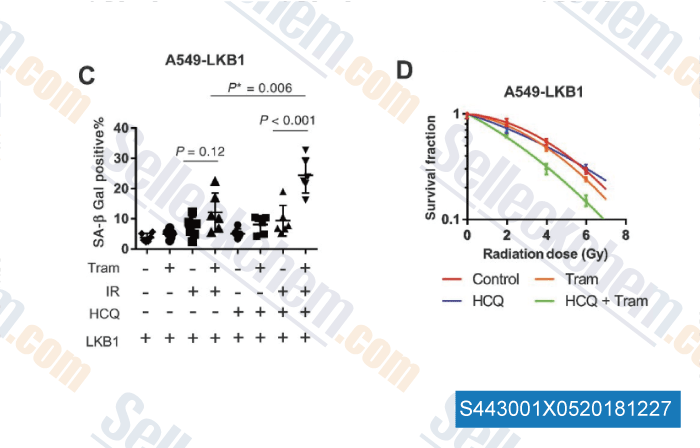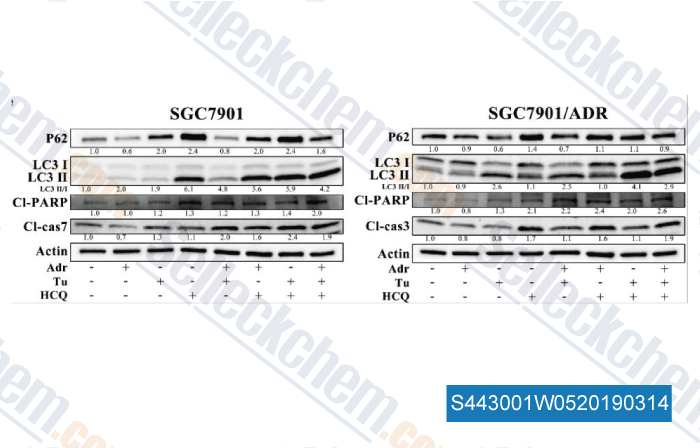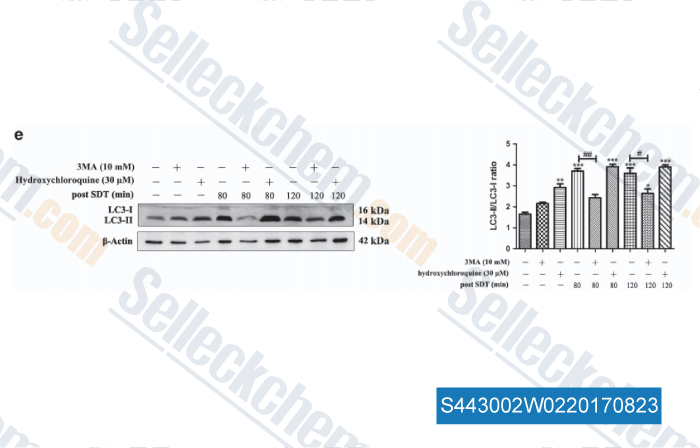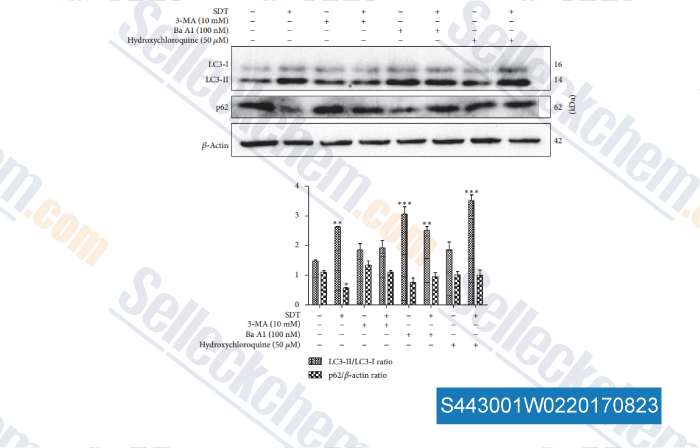|
Toll Free: (877) 796-6397 -- USA and Canada only -- |
Fax: +1-832-582-8590 Orders: +1-832-582-8158 |
Tech Support: +1-832-582-8158 Ext:3 Please provide your Order Number in the email. |
Technical Data
| Formula | C18H28ClN3O5S |
|||
| Molecular Weight | 433.95 | CAS No. | 747-36-4 | |
| Solubility (25°C)* | In vitro | Water | 86 mg/mL (198.17 mM) | |
| DMSO | Insoluble | |||
| Ethanol | Insoluble | |||
|
* <1 mg/ml means slightly soluble or insoluble. * Please note that Selleck tests the solubility of all compounds in-house, and the actual solubility may differ slightly from published values. This is normal and is due to slight batch-to-batch variations. * Room temperature shipping (Stability testing shows this product can be shipped without any cooling measures.) |
||||
Preparing Stock Solutions
Biological Activity
| Description | Hydroxychloroquine (HCQ) Sulfate is an antimalarial agent used for the treatment of systemic lupus erythematosus, rheumatoid arthritis and other autoimmune, inflammatory and dermatologic conditions. Also acts as an inhibitor of autophagy and toll-like receptor (TLR) 7/9. | ||
|---|---|---|---|
| Targets |
|
||
| In vitro | Hydroxychloroquine Sulfate is a potent inhibitor of autophagy. It prevents lysosomal acidification, thereby interfering with a key step in the autophagic process.HCQ treatment inhibits RCC (renal cell cancer) cell growth, promotes apoptosis, inhibits mitochondrial oxygen consumption, and increases rates of glycolysis[2]. |
||
| In vivo | The treatment of Hydroxychloroquine Sulfate reduces the infarct size in an in vivo rat model of I/R injury and the cardioprotective effect of Hydroxychloroquine is ERK1/2 dependent[3]. In addition, Hydroxychloroquine Sulfate shows an early vascular protective effect. HCQ seems to prevent the occurrence of endothelial dysfunction(ED) in treated animals[4]. |
Protocol (from reference)
| Kinase Assay: |
|
|---|---|
| Cell Assay: |
|
References
|
Customer Product Validation

-
Data from [ , , Clin Cancer Res, 2018, doi:10.1158/1078-0432.CCR-18-1489 ]

-
Data from [ , , J Exp Clin Cancer Res, 2018, 37(1):272 ]

-
Data from [ , , Cell Death Dis, 2017, 8(1):e2558 ]

-
Data from [ , , Oxid Med Cell Longev, 2017, 8519169 ]
Selleck's Hydroxychloroquine (HCQ) Sulfate Has Been Cited by 127 Publications
| Reticulophagy receptor FAM134C restrains BMP receptor signaling [ EMBO J, 2025, 10.1038/s44318-025-00581-3] | PubMed: 41116059 |
| BMAL1-depletion remodels ceramide metabolism to regulate ferroptosis and sorafenib chemosensitivity in acute myeloid leukemia [ iScience, 2025, 28(4):112054] | PubMed: 40241743 |
| MYC Overexpression Enhances Sensitivity to MEK Inhibition in Head and Neck Squamous Cell Carcinoma [ Int J Mol Sci, 2025, 26(2)588] | PubMed: 39859304 |
| Gossypin induces apoptosis and autophagy via the MAPK/JNK pathway in HT‑29 human colorectal cancer cells [ Int J Mol Med, 2025, 56(1)107] | PubMed: 40376978 |
| Glycopolymer nanomicelles: pH-responsive drug delivery, endocytosis pathway, autophagy behavior, and the effect of autophagy inhibitors [ J Mater Sci-Mater M, 2025, 36(1):47] | PubMed: 40478478 |
| TRIM22 inhibits the metastasis of colorectal cancer through facilitating β-Catenin degradation [ Exp Cell Res, 2025, 446(2):114473] | PubMed: 39978715 |
| Pyrimethamine Inhibits Human Ovarian Cancer by Triggering Lethal Mitophagy via Activating the p38/JNK/ERK Pathway [ Oncol Res, 2025, 33(9):2421-2434] | PubMed: 40918465 |
| Itaconate drives pro-inflammatory responses through proteasomal degradation of GLO1 [ Biochem Biophys Res Commun, 2025, 747:151292] | PubMed: 39787788 |
| Platelet factor 4 modulates endothelial cell antimicrobial activity to enhance bacterial clearance and improve sepsis outcomes [ bioRxiv, 2025, 2025.09.02.673783] | PubMed: 40950105 |
| Inhibition of ethanol-induced eNAMPT secretion attenuates liver ferroptosis through BAT-Liver communication [ Redox Biol, 2024, 75:103274] | PubMed: 39059204 |
RETURN POLICY
Selleck Chemical’s Unconditional Return Policy ensures a smooth online shopping experience for our customers. If you are in any way unsatisfied with your purchase, you may return any item(s) within 7 days of receiving it. In the event of product quality issues, either protocol related or product related problems, you may return any item(s) within 365 days from the original purchase date. Please follow the instructions below when returning products.
SHIPPING AND STORAGE
Selleck products are transported at room temperature. If you receive the product at room temperature, please rest assured, the Selleck Quality Inspection Department has conducted experiments to verify that the normal temperature placement of one month will not affect the biological activity of powder products. After collecting, please store the product according to the requirements described in the datasheet. Most Selleck products are stable under the recommended conditions.
NOT FOR HUMAN, VETERINARY DIAGNOSTIC OR THERAPEUTIC USE.
